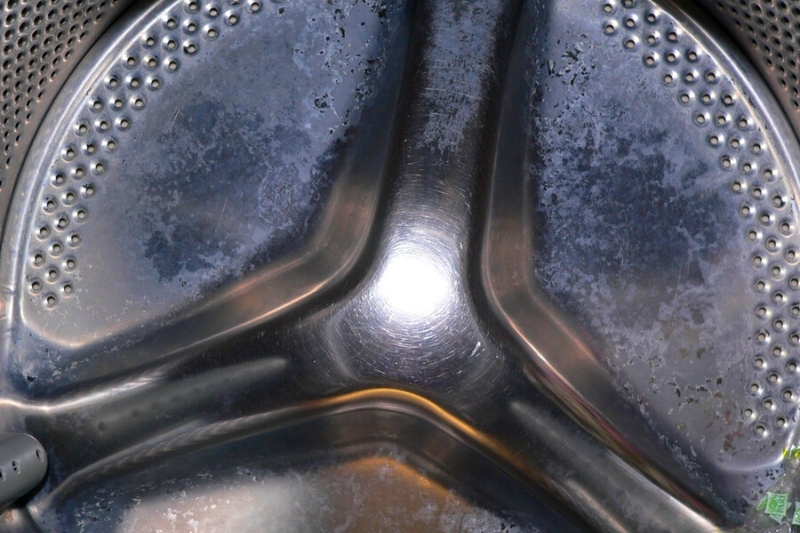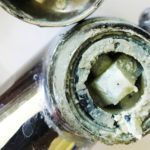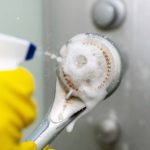Limescale is a common issue around the home, especially in hard water areas. No matter how hard you try and keep on top of cleaning, the chalky deposits always make an appearance.
They ruin not only the appearance of your taps, but also interfere with the functioning of your appliances, and your washing machine is a prime target.
The washing machine is one of the most common places to find limescale build-up. The deposits can form in the drum and must be cleaned before it transfers onto your clothes.
However, limescale isn’t always noticeable and can be found in vents, filters, and heating elements. This makes it particularly challenging to eliminate limescale in the washing machine.
Fortunately, we know just how to overcome this challenge! Read on to learn how to get rid of limescale in a washing machine and help prevent further build-up in the future.
How to Remove Limescale in the Washing Machine
Limescale is notoriously hard to get remove from washing machines. If you manage to wipe away the chalky deposits early on, the cleaning process isn’t too bad, but waiting until the limescale has built up results in a lot of scrubbing and a near-impossible cleaning task.
Limescale is primarily made up of calcium carbonate deposits left behind when water comes into contact with a surface.
To effectively break through the calcium build-up, you will need to use a cleaner that has a high acidic content.
Once the limescale has been dissolved, it can easily be washed down the drain, leaving your washer as good as new.
Commercial cleaners are made with this in mind, but several DIY alternatives will do the trick as effectively. Each of these is detailed below.
1. Commercial descaler
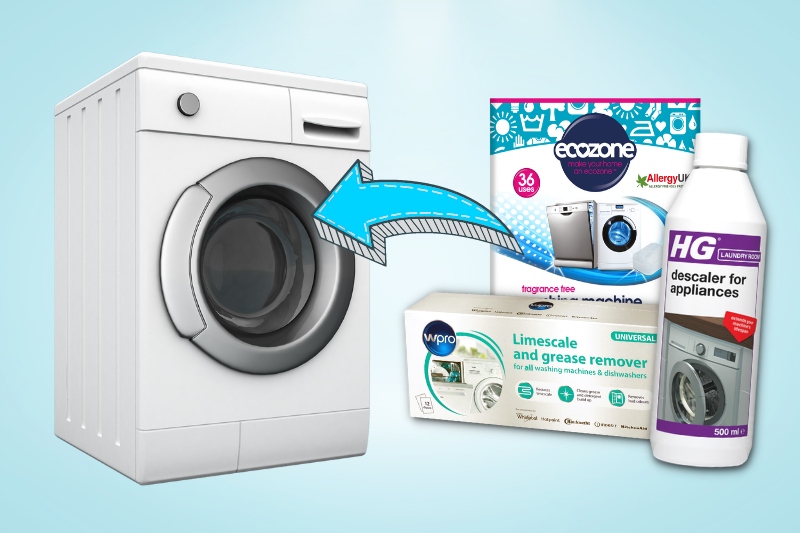
Commercial descalers are specifically designed to remove tough patches of limescale from around the home.
These products contain various chemicals to cut through the limescale deposits effectively (if you want a more natural alternative, we recommend trying one of the below cleaners instead).
The descalers available for washing machine use come in powder, liquid, or tablet form. Ecozone Tablets, Hotpoint Sachets, and HG Liquid Descaler are great examples that always rake in good reviews.
These products all work equally as well, so the kind you choose can be based on your personal preference. Always use the descaler according to the label instructions for the best results.
2. White vinegar or lemon juice
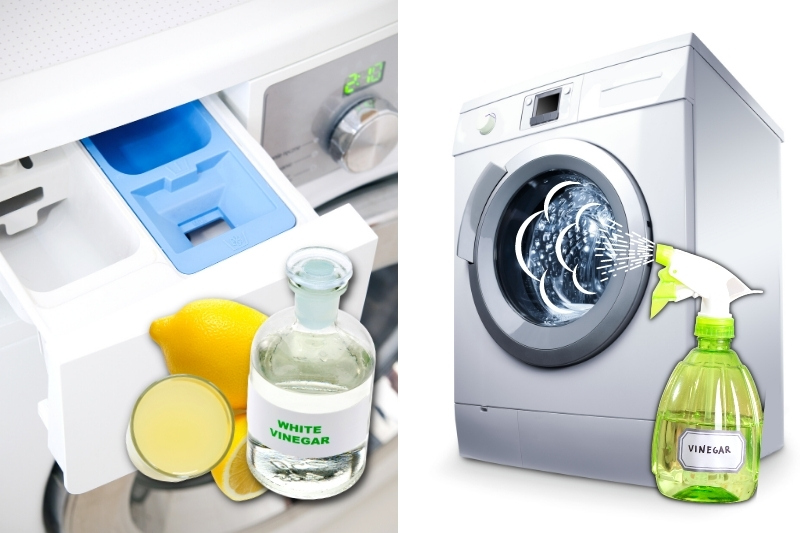
If you’ve decided that a commercial descaler is not for you, two of the best natural alternatives to try are white vinegar and lemon juice.
These household ingredients are both highly acidic, meaning they work wonders when it comes to cutting through tough limescale deposits.
Although these cleaners can be used on their own, they can also be combined to increase their effectiveness.
To remove limescale from your entire washing machine, use the following method:
- Make sure your washing machine is empty before starting.
- Add 500 ml of cleaner (either one of the two ingredients or a 50/50 mixture) to your machine’s detergent drawer and run a 60-degree cycle.
- Repeat the wash cycle, but this time without any cleaner.
If you’ve already tried the above steps and there are still specific areas of build-up in the drum, you can use these instructions instead to tackle the excess limescale:
- Fill a spray bottle with your cleaning solution (either vinegar, lemon juice, or a 50/50 mixture).
- Soak the stubborn limescale deposits with the cleaner.
- Leave it to sit for 30 minutes.
- Scrub at the deposits with a stiff brush until all traces of limescale have been removed.
- Rinse the machine out with clean water.
3. White vinegar and bicarbonate of soda
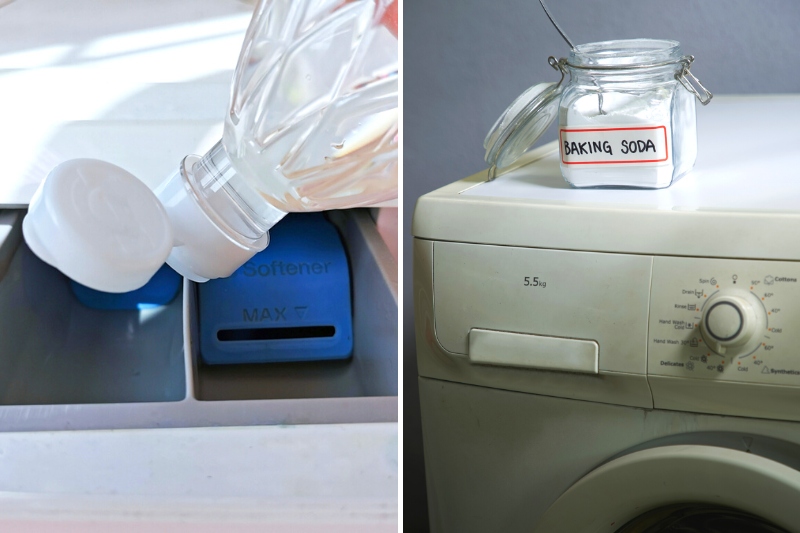
Another powerful cleaning combination is white vinegar and bicarbonate of soda. When combined, these ingredients create a chemical reaction that causes them to fizz up and remove nearly any form of dirt and grime.
To use these ingredients to clear out your washing machine, you need to:
- Make sure your washing machine is empty.
- Add 500 ml of white vinegar to the detergent drawer.
- Place 100g of bicarbonate of soda into the drum.
- Run a 60-degree wash cycle.
- Repeat the wash cycle, but without the descaler.
If you have particularly stubborn areas of limescale in your washer’s drum, you can also use the below steps to target these specific areas.
- Fill a spray bottle with white vinegar.
- Saturate the limescale deposits with the vinegar, then leave for at least 30 minutes.
- Once 40 minutes have passed, sprinkle bicarbonate of soda on top of the deposits.
- Use a stiff brush to scrub at the deposits until all traces of limescale are removed.
- Rinse out the drum with clean water.
4. Bicarbonate of soda

Your final option for descaling your washing machine is to use bicarbonate of soda on its own.
The abrasiveness of the powder means that bicarbonate can effectively scrub away limescale deposits. However, this ingredient is not acidic, meaning it is best left for minimal levels of build-up.
To get the best results, you need to use bicarbonate of soda in the following way:
- Make sure that your washing machine is empty
- Add 100g of bicarbonate of soda to the machine drum
- Run a 60-degree washing cycle
- Repeat the wash cycle, but without the bicarbonate of soda.
Can Limescale Damage a Washing Machine?
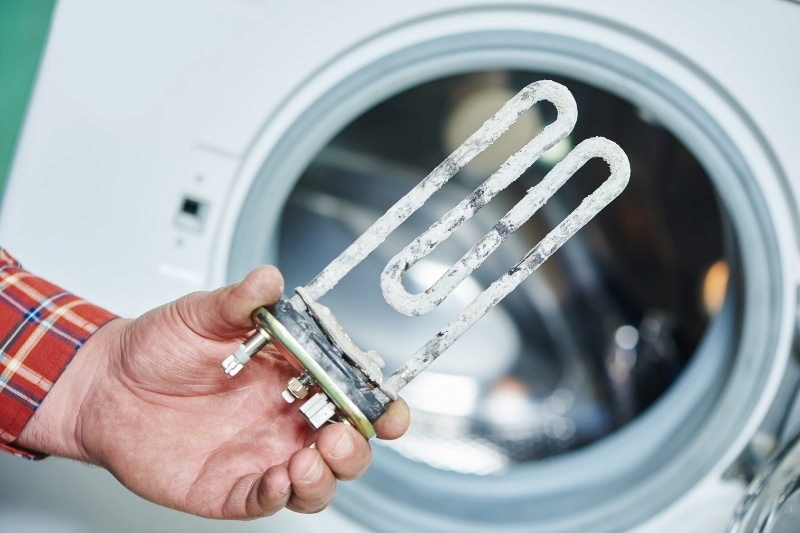
Yes, limescale can damage your washing machines! It does this in two ways:
- Malfunctioning thermostat: Limescale deposits tend to first build up on the heating element of your machine. When this happens, the sensor won’t be able to obtain a proper reading of the water temperature during a wash cycle. This will result in more energy used during a cycle, increasing your electricity bills.
- Blocked vents & filters: As more calcium deposits accumulate, the limescale will eventually block your washer’s vents and filters and can cause the drum and pipes to wear away. Overall, this will increase the likelihood of leaks and will eventually result in your machine malfunctioning and needing to be replaced.
These damages highlight why it’s vital to get rid of any limescale deposits as soon as they’re noticed.
Not only does this make the cleaning process easier for you, but it minimises the damage to your appliance and extends the lifespan of your machine.
Unfortunately, people rarely look closely at the inside of their washing machine, so it’s easy to miss the gradual build-up of limescale.
When left unchecked, these deposits will slowly build up in the drum, vents and filters, and the heating element of your machine, causing continual damage.
How Do You Stop Limescale Build-Up?
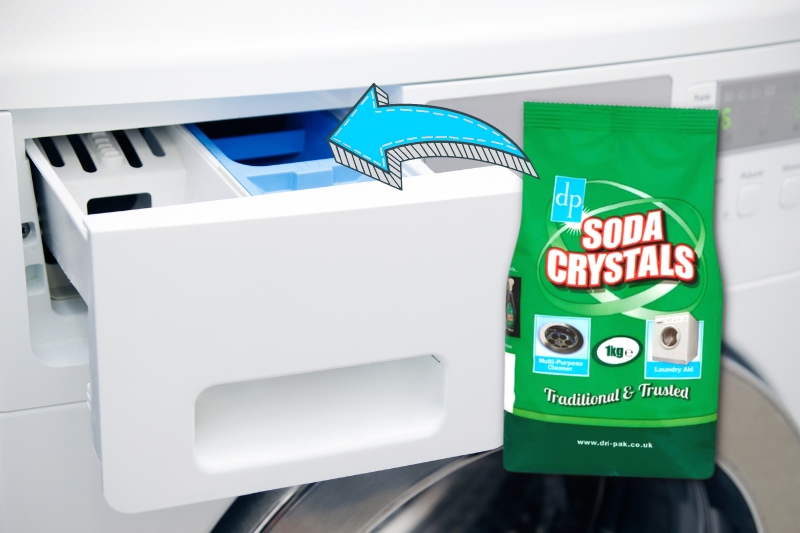
Once you have descaled your washing machine using one of the above methods, you may be wondering whether there is any way to prevent limescale build-up in the future.
Although you won’t be able to stop the formation of limescale completely, there are a few things you can do to prevent it from damaging your machine:
- Make it a habit to descale your washing machine every other month to prevent any limescale deposits from thickening and clogging essential parts of your washing machine.
- Use a water softener during each wash to neutralise any minerals in the water. There are many options available, but we recommend trying Calgon as it is repetitively a best seller.
- Alternatively, use soda crystals in each wash for the same effect. Simply add two tablespoons of the crystals into the detergent drawer alongside your laundry detergent.
- Install a water-softening device to remove minerals from your water supply before they enter the machine. This includes the removal of calcium ions, preventing their accumulation.
- Install an anti-limescale magnet in your washer. There are currently no studies that prove these magnets work, but many people boast good results after installing one.

Hannah has a passion for cleaning. She worked her way around Australia by cleaning hostels in exchange for free accommodation and used her cleaning skills to bag a job as a chalet host for a luxury ski company in France.
